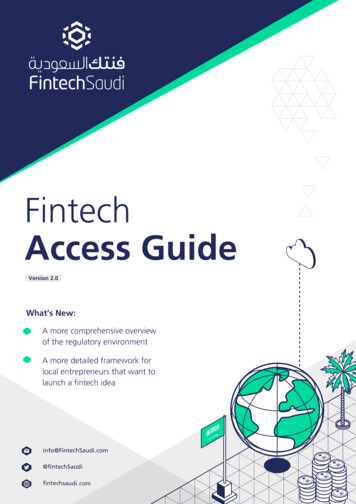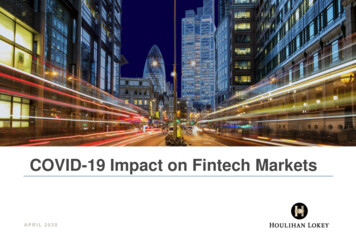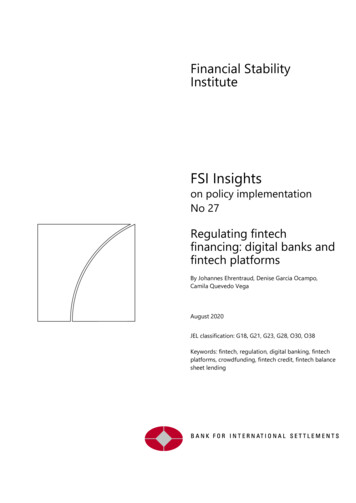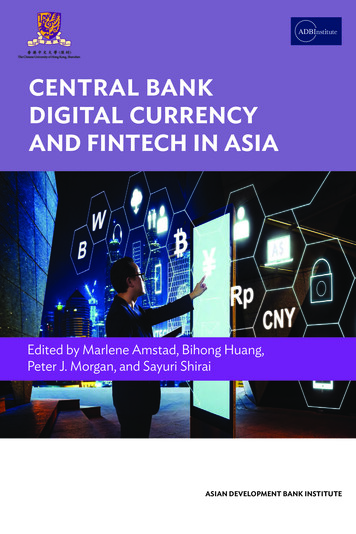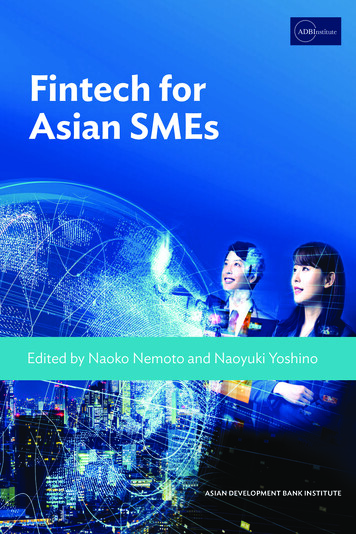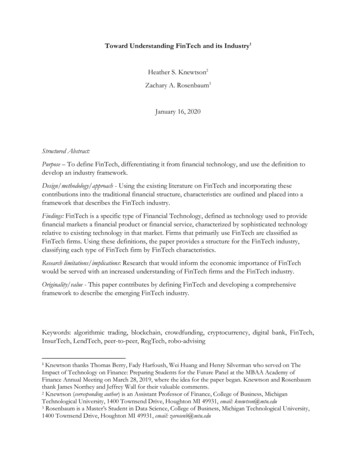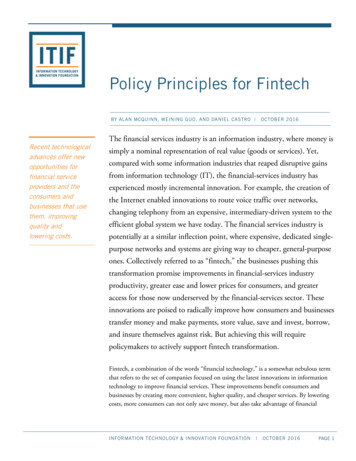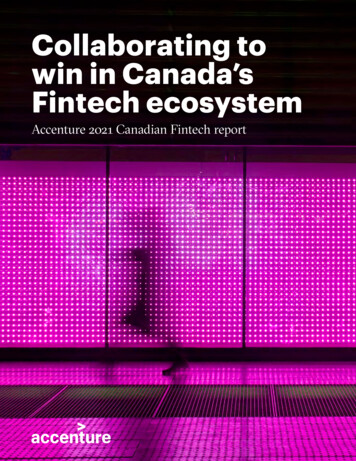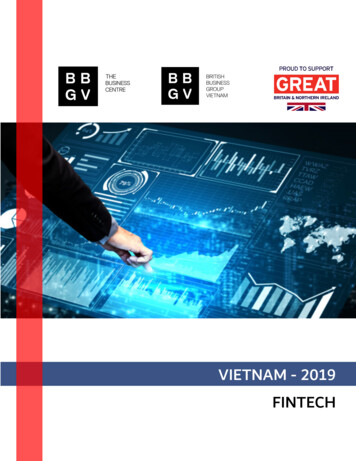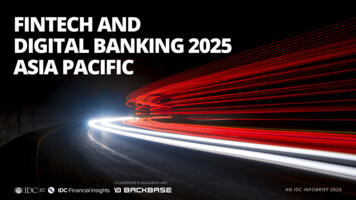
Transcription
FINTECH ANDDIGITAL BANKING 2025ASIA PACIFICCo-published in association withAN IDC INFOBRIEF 2020
Fintech & Digital Banking 2025 Readiness ChallengesFive years ago, IDC Financial Insights predicted that 100% of the top 250 banks across Asia Pacific would be executing a digital strategy. The reality? We are far from that number.Digital-first banking is even more important now as the COVID-19 situation has intensified customers’ need for availability, access, and control of digital channel interactions.Legacy Views of Value ChainPoor Customer AdoptionBanks have not been able to take advantage of potential ecosystempartners as they still hold traditional views of the value chain.This is due to extreme focus on channels,disregarding necessary integration withbusiness processes.80% of the top 250 banks still prefer to own the entire value chainof banking, with third party-contributed business at a mere 2%.70% of Asia Pacific banking customers viewbanking processes as tedious. Only 30%of the banking customer base is active ondigital banking channels.Core Systems LaggingBanks still find it too difficult and expensiveto transform legacy core systems.Average age of core banking systems inthe top 100 banks in Asia Pacific remainsat 17.5 years — hardly responsive andup-to-date with the demands of thedigital era.Lack of Customer InsightsBanks have not been able to comeup with customized strategies for thecustomer segment of one.Only 20% of banks in Asia Pacificbelieve they truly understandtheir customers.An IDC InfoBrief Fintech and Digital Banking 2025 Asia PacificFintech& DigitalBankingReadinessChallengesSlow to InnovateInnovation momentum is easier built from the ground up, whiletraditional banks are held back by traditional products, processes,and people.63% of banking customers in Asia Pacific are willing to switch to neobanks or new digital challengers.More than 35 neo banks or new digital challengers across AsiaPacific are built on agile innovative best practices — way ahead ofincumbents in terms of flexibility, self-service capabilities, customerneeds, and personalization. 38% of revenues of traditional banks areat risk by 2025 because of emerging new players and further digitaldisruption in the industry.Limited Impact From New ChannelsNew channels like voice, chatbots, and robo-advisoryare growing at an accelerated rate, but do notnecessarily change customer behavior quickly.Only 22% of the banking customer base has usedthese new channels in 2019.2
2020 to 2025: Calling for a ‘Different’ Type of Digital-FirstNot soon after the start of 2020, the industry saw how different the next few years would be, shaped by new, unusual, and extreme forces.Shouldn’t the standards of digital-first change drastically too?The escalation of COVID-19 shows how banksmust be able to change strategies with greatagility. Course correction will be needed fora bank’s channel mix, customer engagementstrategies, and business processes.Low interest rate environmentforecasted for the short to mediumterm means banks must not onlyprotect traditional businesses that arebased on net interest margins, butmust also quickly build other sourcesand types of income.There will be new regulatory mandatesto ensure that banks support quickeconomic recovery. Banks must buildup digital-first strategies in a newenvironment of risk andregulatory compliance.An IDC InfoBrief Fintech and Digital Banking 2025 Asia PacificA downturn means banks mustbe able to communicate trust andreliability — which calls for higherstandards of access, availability, andease of use for digital channels.Challengers to traditional banking— neo-banks, fintechs, and techdisruptors — will take advantageof a customer’s need for theirbank to “get” me.Risk aversion spills over to the technologyinvestments of banks — more carefulspending, reliance on X-as-a-service, andgreater emphasis on return on investment(ROI). Technology investments should notdisadvantage banks through higher IT andops expenses.3
Strategic Investments & Growth Priorities for 20252020 to 2025 will be a period of accelerated pursuit of digital-first by banks across Asia Pacific.It is all about being even more customer-driven and platform-oriented. Ultimately, unleashing the potential of personalization at scale in the digital-first story.Let’s take a look at what banks will be concentrating on from 2020 to 2025.Non-Negotiables of Great Customer ExperienceModern Core BankingFast turnaround time, conversational banking, and personalization atscale are the top three factors driving customer loyalty.44% of the top 250 banks across Asia Pacific will complete their“connected core” transformation — working on platform-based andcomponentized modernization, and API-enablement.High-Impact Business ProcessesEcosystem Strategies That Call for AgileBanks across Asia Pacific target to attain 80% improvements overall tobusiness processes. This includes: know your customer (KYC), onboardingand origination, credit collections, and advisory.60% of banks in Asia Pacific will grow their ecosystems, integratingfintech solutions from cloud marketplaces, enriching transactionsfrom the banks’ core system.Truly Omni-Channel, Truly Omni-ExperienceLifestyle IntegrationOn average, a bank in Asia Pacific will manage at least 20 channels. Banks areincreasingly focused on interactions, not just transactions, with new ways tointeract, such as pre-staged transactions and intelligent automation.Six lifestyle ecosystems will be prioritized by the majority of banks inAsia Pacific: home, health, entertainment, retail, transport/travel,and education.Open BankingRegulations across Asia Pacific around Open Banking require banks to permitcustomers to share their own transaction data with third parties made possiblethrough application programming interfaces (APIs). By 2020, 40% of Asia Pacificbanks will have invested in API management platforms.Revenue SourcesSmart and Intelligent BankingRecommendations and Advisory-Based48% of banks in Asia Pacific will leverage artificial intelligence (AI) ormachine learning (ML) technologies for data-driven decisions.It is predicted that 18% of a bank’s business in Asia Pacific will beadvisory-based by 2025, and will continue to grow. Banks need the ability toproactively reach out to customers at the right time, with the right advice and offer.An IDC InfoBrief Fintech and Digital Banking 2025 Asia PacificIn corporate banking, 5% of revenues will be driven by new digital businessmodels such as X-as-a-service on cloud-based marketplaces. In retailbanking and wealth banking, this stands at 4% and 2%, respectively.4
Survival of the FittestThe Race to Be Digital-FirstBeing digital-first calls for integration of digital technologies with the comprehensive transformation of business processes, engagement strategies,channels, and business models of banking. Who will win the race in 2020 to 2025?Neo BanksThe Asia Pacific region is expectedto see 100 new financial institutionsby 2025, ushered in by liberalizationof several markets and the issuanceof new banking licenses.Big TraditionalIncumbentsScale was the advantage of theseincumbents — typically the big fourin Asia Pacific markets, but scale nowconnotes high cost-to-income andhigh cost-to-serve.This diverse collection of neo banks(pureplay digital banks, paymentbanks, and financial aggregators)are expected to compete oneverything — including price andexperienced hires.Being digital means these players areable to achieve operational efficiency.For some of these players, the optionis to launch digital brands.These players plan to winprimarily through agile anddigital-first capabilities.For banks in Australia and Singaporethat are already operating on lowcost-to-income, being digital-first letsthem aspire for even moreoperational efficiency.An IDC InfoBrief Fintech and Digital Banking 2025 Asia PacificMid andSmall-Tier BanksNiche propositions are still possiblein the region. However, withoutscale and talent with the digital skillsets, mid and small-tier institutionswill find it hard to find ROI of theirtechnology investments.The best alternative is to partnerwith fintechs, technology firms,and even other banks tocomplement and supplementvalue needed by these players.Partnerships might be based onas-a-service and on-demandmodes of technology acquisition.FintechsThe success rate of fintechs ishigher than expected in the 10key markets in Asia Pacific. Theseplayers should partner aggressivelyto build revenues in the quicklygrowing digital banking opportunity.Aggregation of customer dataand integration of digitaltechnologies through amarketplace might be the mosteffective way to build a market.MarketInfrastructurePayment networks, sharedservices, and financial communityassociations contribute tothe race to digital by creatingframeworks of cooperation andnew business models.Market infrastructure shouldhelp by making it easierfor individual parties to take ondigital innovation.5
Retail, Corporate & Wealth BankingWhat Does Digital-First Look Like?Retail andConsumer BankingCorporateBankingWealthManagementResponding to an increasingly digitalcustomer (preference to transact throughdigital channels)Real-time payments and executionQuick delivery of information needed and to removetedious, manual, and low value-add tasks to boostrelationship manager/advisor’s productivityPersonalization down to thecustomer of oneTreasury and corporate functions open tointegration of products, services functionalities,and data from third partiesSelf-service capabilities augmented withhuman assistance as neededQuick speed to complete a transactionIntelligent decisions and automated processesfor high-impact business processes(e.g., corporate KYC)Better tools to show clients the basis for andimpact of the insights offered and improvedadvice on risk mitigationUse of insights from personal data (customerpreferences, customer behavior, and transactiondata) to bundle and re-bundle products and servicesUse of big data and analytics (BDA), and AI/MLto bring intelligence into cash management andliquidity forecasting services to their clientsUse of BDA and AI/ML to bring intelligenceto decisionsInstantaneous delivery of products, services,and informationLower cost of operations through cloudand technology platformsStreamlined, rapid onboardingAn IDC InfoBrief Fintech and Digital Banking 2025 Asia Pacific6
CountryHighlights
2025 Australia Banking Outlook & OpportunitiesDigital-first is key to cope with the challenging conditions; high customer adoption of digital together with regulated open banking present significant opportunities forbanks with the capabilities to adapt, offering holistic solutions and personalizing at scale.OUTLOOKOPPORTUNITIESModern and Modular ArchitectureBy 2025, Australia will reach90% of retail transactionsthrough mobile.80% of banking assets in Australia willstill be dominated by the Big 4. Smalland mid-tier banks will be challenged bya combination of legacy systems,lack of digital talent, and lack ofexperience in executing large-scaledigital transformation.35% of IT budgets among Tier 1and Tier 2 banks will be spent on“new” ― new technologies and newcategories of spending. There willbe growing challenge in integratingthese with legacy systems.The use of AI for customermanagement is expectedto increase revenue in retailbanks by 15% and wealthmanagement by 10%.An IDC InfoBrief Fintech and Digital Banking 2025 Asia PacificBanks could potentially achieve under-40 cost-to-income ratios and agility with an open API-basedplatform that allows for any third-party fintech capability to easily integrate and leverage intoseamless digital customer journeys across all channels.Banks should allow for two-speed architecture ― combining the best of the old and new. A smartcustomer experience layer can work in harmony with core systems, introducing the flexibilitybanks need to compete without having to replace core systems. Functionalities can be reusedand swapped around as needed, and banks can react to market changes quickly and meet CDRobligations at the same time.Own the Customer Financial LifeBy becoming better aggregators of customer data, banks can go beyond static analysis of historicalbehavior to actively predicting it with AI/ML tools, which brings banks into the realm of smart andintelligent banking. It involves reaching into the future, to actively craft customer journeys andconsistently provide timely, optimal solutions. Essentially, the bank becomes part of the customer’sdecision-making process and financial life.From the customer’s point of view, true open banking allows them to access all aspects of theirfinancial life at one location, rather than juggling multiple disparate services.Memorable Customer ExperiencesHyper-personalization at scale through mobile experiences is key as the fight to be a superapp intensifies. However, a once-off mobile app should be avoided. Instead, banks must creatememorable and composable omni-channel capabilities that are smartphone-friendly, but can easilybe used across other customer touchpoints including online banking, or even face-to-face channels(e.g., high caliber and customer-oriented business relationship managers driving SME lendinginteractions).There is opportunity to win more business in time-sensitive areas (e.g., loan approvals), and removecost as interest margin compression continues and transaction fee income decreases.8
2025 Vietnam Banking Outlook & OpportunitiesVietnam banks build scale on top of highest-ever growth in digital investments, but the smaller banks look to succeed first.OUTLOOKOPPORTUNITIESOwn the Customer ExperienceMobile transactions inVietnam are expected toincrease by 400%.50% growth in newaccounts by the top 8banks is expected, usingintelligent automation inaccount origination.25% of banks in Vietnamwill “actively pursue moderndigital core platforms”.Banks must ensure they secure ownership of the customer experience. This is essential, otherwisethey run the risk of opening up APIs, giving away data to the competition, and failing to add anyvalue to strengthen their own position.Joint stock banks in particular are poised to win a larger market share thanks to enhancedfeatures in their mobile offerings. This includes gamification, improved data security, andcustomer journey designs for integrated omni-channel customer experiences to crack the psycheof customers. Each touchpoint, be it digital or human, should connect all other componentsseamlessly and eliminate friction.Accelerate Innovation Through Fintech PartnershipsFintech partnerships, both locally and regionally, can add a competitive edge. Banks can leveragecloud marketplaces to enable plug-and-play access to fintech solutions, such as superior onboardingand origination solutions to drive lending.In a digital world, the bank is no longer the sole creator of value for its clients. Today, competitivestrength comes from having good connections with other players and from adding or sharing value.Banks must use open APIs to connect, both internally and to third parties, to ensure they can keeptheir customer base interested.Watch for Success from Small but Wonderful Digital-First BanksTOP 2Core banking and paymentssystem modernization are thetop 2 priorities among the top8 banks in Vietnam.An IDC InfoBrief Fintech and Digital Banking 2025 Asia PacificAs recovery from 2020 challenges unfolds, the market’s digital story will be seen through a newclass of institutions: the partially private bank segment. These institutions have characteristicallysmaller asset portfolios, but asset quality will be generally higher in this segment. They will alsomake proportionately higher IT investments particularly in mobile channels and mobile channelexperience, branch digitalization, and workflow optimization to support an increasingly digitalconsumer banking segment. These are the digital-first banks to watch.9
2025 Philippines Banking Outlook & OpportunitiesExpect the Philippines to have the largest market share migration in the Asia Pacific region, as customers move toward digital-first banks.OUTLOOK80% of customers will opennew bank accounts with otherbanks, diluting “primary bank”relationships.75% of bill payments will be donethrough mobile channels, up from18% in 2019.Unbanked and underbankedsegments in the Philippines areexpected to cut by half to around20% of the bankable population.OPPORTUNITIESAddress the Unbanked and Underbanked70% of customers who are active on digital apps believe they do not have options for“value add” banking products. New capabilities from fintechs, especially payments andlending, will fill the gap in financial inclusion. Banks to co-create features with fintechs,improve distribution of digital banking services, and integrate mobile payments moredeeply in the day-to-day lives of new customer segments.Move from Plain-Vanilla to Distinctive60% of bankable customers are willing to shift to other players that are more digital.Banks should deliver unique products ideated through customer data analytics.Fintechs and distribution partners will accelerate customer adoptionwith personalization content and frictionless experiences within digital channels.Onboard New Customers Faster Than EverAverage number of products percustomer in the Philippines willrise to 4, excluding products jointlyoffered by banks and theirnon-bank partners.An IDC InfoBrief Fintech and Digital Banking 2025 Asia PacificBanks should protect and grow market share through electronic KYC and identityverification. All this, supported by a modern digital platform that enables sharing of data,functionalities, and processes with third parties, to significantly accelerate onboarding ofnew customers.There is opportunity to reap returns with electronic KYC and customer identity integration,coupled with investments in workflow automation on digital platforms.10
2025 Indonesia Banking Outlook & OpportunitiesIndonesian bank customers will maintain multiple digital loyalties, including those with non-bank digital platforms. Traditional banks can retain loyalty through theuse of data to show that “my bank understands me”.OUTLOOKBY 2023, 40% of Indonesianbankable customers will go throughdirect onboarding, electronic KYC,or third-party onboarding.25% growth of investments intoreal-time capabilities (marketing,fraud management, and payments)is expected.5Tier 1 and Tier 2 Indonesianbanks will operate within atleast 5 lifestyle ecosystems.OPPORTUNITIESModern and Modular ArchitectureA modular architecture paves the way for faster, more agile ways of working. This can be through cloudplatforms to improve uptime, reliability, and stringent standards of 24/7 banking services. Supported by thisLEGO-style building block architecture, it is possible to create and alter processes, products, or channels asneeded. Changes are easily made, by small business teams, with minimal impact on the business.For example, business owners can be increasingly creative in sales and service design, while engineering canquickly develop and launch new value propositions. Modular banking is the key to fine-tuned processes, andwill drive any efforts to create a future-proof digital banking platform.Accelerate Innovation Through Fintech PartnershipsBanks should escalate investments to compete on “real-time” ― focusing first on payments,then digital marketing, fraud management, and product offers. This can be achieved morequickly through fintech or third-party collaborations to process services more quickly,deliver superior user experiences, and gain scale.Talent UpskillingBanks to invest in talent upskilling especially in the areas of new digital technologies(AI/ML) and software development skills. This can help banks better integrate multipledisconnected back-end systems into a single, seamless digital customer experience.Indonesian banks are expected totriple the use of big data and AI/MLto improve customer experiences.An IDC InfoBrief Fintech and Digital Banking 2025 Asia PacificThis can be in the form of moving to paperless, digitized processes, and translate customerdata into valuable insights that help customers make better financial decisions. Thisprocess requires some thought, and a business model with the right talent investment.11
2025 Thailand Banking Outlook & OpportunitiesBanks become more prominent not by sheer asset size alone, but through the size and extent of ecosystems they build with third parties.OUTLOOKMore than half of new digitalworkloads in Thai banks will beon public cloud.OPPORTUNITIESModern and Modular ArchitectureA modular set-up paves the way for faster, more agile ways of working. Supported by this LEGO-stylebuilding block architecture, it is possible to create and alter processes, products, or channels as needed.Changes are easily made, by small business teams, with minimal impact on the business.By swapping around different modules as needed, it is possible to customize offerings or add new features,without large deployment efforts. Modules are created once, reused, and infinitely combined, creating a fluidstructure that can be used to respond to the latest customer demands.50% growth of investments intothe management of the wealthbusiness among the top 8 banks inThailand is expected.7% of retail business of Tier 1banks in Thailand will bepartner-generated, up fromunder 2%.44 of the top 6 banks inThailand will see growth of theDevSecOps movement with therise of agile innovation.An IDC InfoBrief Fintech and Digital Banking 2025 Asia PacificAccelerate Innovation Through Fintech PartnershipsBanks should look at expanding partnerships with third parties to deliver customer benefits of “lifestyleoriented” services. The benefits of these innovation centers of excellence have borne fruit in electronicKYC, digital identity integration, and blockchain/distributed ledger technology projects. Banks can continuethis effort by looking at other initiatives in biometrics, AI/ML, customer analytics, and identity-as-a-service,including advisory-based recommendations.Continuous, API-driven collaboration is all part of the larger open network economy trend. Participants willgrow faster as they benefit from a “network effect”. As more banks create integrated value propositions, theywill attract more users, and create more value within the network. Those that get it wrong will fail to gain thatvalue and simply open up their data to competitors.Ensure Reliability and ConvenienceThai customers will quickly adopt digital capabilities if they prove to be beneficial to them. Thailand hasseen record-breaking numbers for growth in digital payments, use of digital IDs, and use of social mediafor banking. The next area primed for growth is platform-based banking, where banks cooperate with thirdparties to offer a unique value proposition to the customer.Welcome to opportunities to integrate banking with consumer retail, healthcare, education, transport, andentertainment. Banks will win by ensuring participation of the right set of third parties working on newbusiness models. In all of this, the benefit to customers must be clear: secure, safe, reliable, and convenient.12
2025 India Banking Outlook & OpportunitiesGovernment and regulators have brought forth the most pro-innovation regime in the world, but banks struggle as their digital-first priorities compete for resources.OUTLOOK75% improvement to turnaroundtime of high-impact businessprocesses for banks in Indiais expected.70% of Tier 1 and Tier 2 banks will regularlyaccess third-party data and insights as theyintensify efforts to personalize customerstrategies ― focusing not only on the“bright” side of banking (marketing, crosssell, and upsell), but also the “dark side”(risk and fraud management).Spending on AI/ML technologies isexpected to increase by 20–25%, ofwhich one-third will be focused onearly fraud detection, cyber threatdetection and security monitoring,and anti-money laundering.15% of Tier 1 and Tier 2 banks’business in India will be underthreat from the neo banks dueto legacy systems.An IDC InfoBrief Fintech and Digital Banking 2025 Asia PacificOPPORTUNITIESModern and Modular Architecture60% of banks in India admit to the struggle in offering intuitive, relevant, andpersonalized content through newly-launched digital channels. Banks should achieveagility to evolving digital propositions, with the ability to integrate with third-partyfunctionalities, and add more features to offerings without spending more on coresystem transformation.The Super Banking App50% of retail transactions in India are done through mobile and dominated bydigital-first banking players. Banks should aim for hyper-personalization at scale throughmobile experiences as the fight to be a super app intensifies. New key performanceindicators (KPIs) around the mobile app experience is crucial. Digital KPIs to be set forspecific productions and points of the customer life cycle.Onboard Customers Faster Than EverWith the Reserve Bank of India’s recently published guidelines on video-based KYCapproval, banks will be able to leverage AI/ML technologies for faster customer onboardingsolutions, and identity verification and authentication, while adhering to compliancerequirements. It is expected that pilot studies with facial and voice recognition will becomemore mainstream and will be integrated with the banking experience.13
Digital Maturity of Fintechs & Banks2020 to 2025 will be all about achieving the twin aims of ensuring high personalization and the ability to bring this to scale.HighPersonalization of Customer ExperienceStandoutsPaytm, Open,MobiKwik,LendingKartPhilippinesTier 1 BanksStandoutsCommonwealth Bankof Australia, NationalAustralia BankStandoutsOVO, Dana, LinkAjaStandoutsPayMaya, Coins.PH,Mynt, First CircleFintechs and DigitalPlatforms in IndonesiaIndonesiaTier 1 BanksAustralianBig FourFintechs in IndiaVietnam JointStock BanksThailandTier 1 BanksFintechs in thePhilippinesNeo Banks inAustraliaFintechs and DigitalPlatforms in ThailandIndiaTier 1 BanksVietnam PublicSector andSmall-Tier BanksIndonesiaMid and SmallTiersIndia Mid andSmall-TierBanksFintechsin VietnamStandoutsSiam Commercial Bank,Kasikornbank, KrungsriStandoutUp BankAustralianMid and SmallTiersStandoutsJitta, Mid and SmallTiersLowHighRepeatability and Scalability of Digital CapabilitiesAn IDC InfoBrief Fintech and Digital Banking 2025 Asia Pacific14
Best of Both Worlds: Personalization That ScalesHow to achieve the twin goals of personalizing to each customer and personalization that scales to be digital-first and 2025 ready?PersonalizationCustomer experience that meetsexpectations of speed ofexecution and personalizationvia the channel of choiceExcellence in business processesthat matter to the customer at thatparticular point in timeConnected experiences that integratechannels, workflow, business process,and personalized contentPersonalized customer interactionsbuilt on knowledge and insightson the customerPersonalization That ScalesOpen, microservices-based, API-enabled coresystems to allow new digital capabilitiesA technology platform to plugand play new functionalitiesOpenness to third parties to provide and consumefunctionalities and applicationsDevelopment of new business modelsacross various business units of the bankAbility to act on what isbest for the customerAn IDC InfoBrief Fintech and Digital Banking 2025 Asia Pacific15
The Benefits of Platform-ThinkingIt is time to think about digital banking platforms as the way to win being digital-first.EsowA lltem Ihnotsteogf praar tion Platfosystners anrmco tion to adraintegfoeea strusted thchnology Plen Te ices through atformOp bility of servusas reersuEnmicroservices andAPIstiolizaat Scalesn ThnDesigns customer life-cyclemanagement strategiesthrough data and insightsnaCustomerStrategy PlanningtiolizaAn IDC InfoBrief Fintech and Digital Banking 2025 Asia PacificsnaExecutes customizedcustomer engagementrti ersoPeFacilitates consistency ofexperience across varioussystems of xperienceOrchestrationir d16
Key Questions to Ask1234How do you distinguish yourself from manyalternatives to be digital-first? Why will digital-savvy customers choose to do business with us? What key digital capabilities do we need to achieve that? Which of those capabilities should we develop versus partner for?Are you focusing enough on the ultimate beneficiary:the customer? How well do we understand the customers’ current needs? Are we measuring what matters to the customer? Which areas of their experience should we prioritize?How do you scale? What hinders us from responding to new insights on customers? How quickly can we update business processes that affect the customer and measure the impact? How easily can we integrate best-in-class third-party solutions that meet identified needs?How do you sustain the journey? How hard is it to introduce change? How much stress does it create across our people? Is the culture built around a future of constant change, with continual measurement informingcontinual adjustment or innovation?Source:1. IDC Perspective: Data as an Asset: Capabilities to Deliver Data-to-Digital (IDC #AP44309018, March 2020)2. IDC Perspective: Many Things from the Shiny New Thing: 20 Early Adopters of Artificial Intelligence in Asia/Pacific Financial Services (IDC #AP43052218, October 2019)3. “New” Customer Centricity: Why, What, Who, and How in the Asia/Pacific Financial Services Industry (IDC #AP45525219, September 2019)4. IDC Perspective: Data as an Asset: A Data-to-Digital Framework (IDC #AP41391317, September 2019)5. IDC Perspective: The Path to Australia-Style Open Banking (IDC #AP41391516, October 2018)An IDC InfoBrief Fintech and Digital Banking 2025 Asia Pacific6.7.8.9.IDC Perspective: From Usin
An IDC InfoBrief Fintech and Digital Banking 2025 Asia Paciic 4 Strategic Investments & Growth Priorities for 2025 2020 to 2025 will be a period of accelerated pursuit of digital-irst by banks across Asia Paciic. It is all about being even more customer-driven and platform-oriented. Ultim
